Day 2: It was 4:40 a.m.
We started our hike in the canyon darkness. The full moon barely lit the way.
A dotted line of white lights shone from the trekkers’ heads.
My headlamp was weak; the white spot looked like 480p quality compared to everyone’s 1080p bright light.
But it was enough for avoiding the heaps of mules’ shit on the ground.
Just 3 more hours and 1100m in elevation to complete the gruelling Colca Canyon trek.
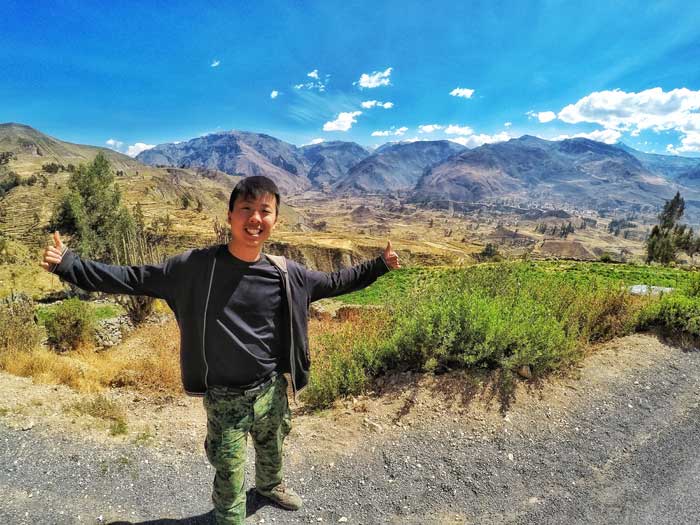
Arequipa - The White City
I finally arrived in Peru after 5.5 months of travelling, and my first stop was Peru’s ‘most beautiful city’ - Arequipa. Crossing the border from Bolivia to Peru is a painless process, thanks to Peru Hop. Read my friend Jordan's review on Peru Hop here.
The city’s colonial buildings looked more European than Latin America; and flanked by 3 snow-capped mountains, it is a ridiculously photogenic place to visit.
In fact, when I was there, several artists took their spots in the city’s main plaza and painted their versions of this UNESCO-declared city, while locals and tourists looked on.
But the main attraction in Arequipa isn’t the city itself, but the nearby Colca Canyon.
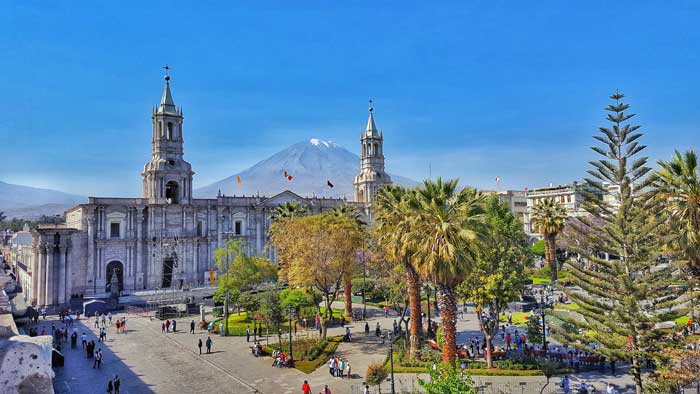
Colca Canyon - Claim to Fame
Depending on how you measure it – some say 3400m, some say 4160m - the Colca Canyon is one of the top 3 deepest canyons in the world; almost twice as deep as the more famous Grand Canyon.
With such a claim to fame and so easily accessible from Arequipa, I had to see it for myself.
Hundreds of tour agencies lined the streets of Arequipa and all offer tours and multi-day treks to the Colca Canyon.
I decided to go for the 2-day trek and it felt just right.
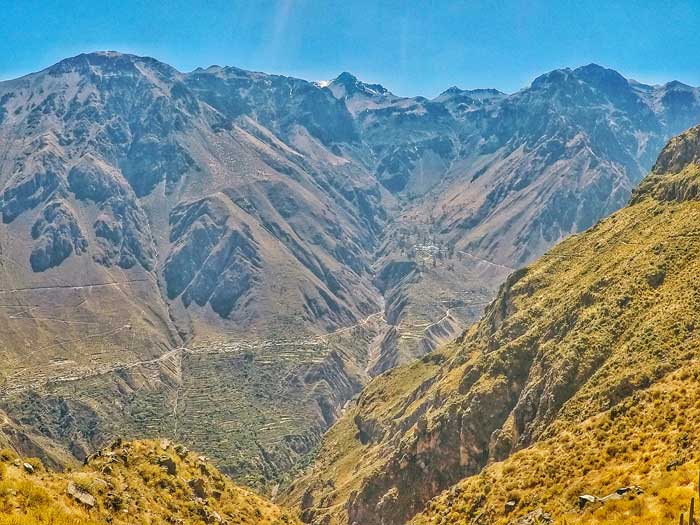
Trek Day
Located at 160km from Arequipa, the hotel pick-up starts at 3am. It is an almost 3-hour ride before paying the entry fee of PEN $70 / USD $21 (August 2017) and stopping at the small town of Chivay for breakfast.
Breakfast is the typical South American fare of a few pieces of bread, jam, butter and coffee. Not exactly fuelling - so bringing some snacks is a good idea.
We stopped at the viewpoint La Cruz del Condor to view the Andean condors, one of the three sacred animals in Peru legends. The viewpoint was filled with hundreds of tourists, all holding out their cameras, hoping to get a good shot of the very few condors.
Condors are supposed to be the biggest birds in the skies, but here, they were tiny. With hundreds of eager tourists, I’m not surprised that the birds preferred to stay away.
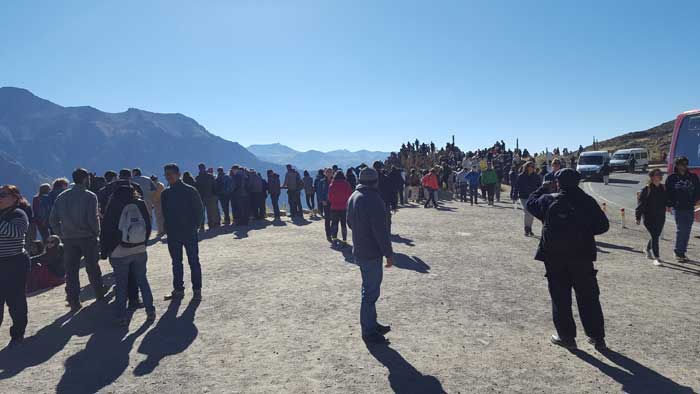
Group Up: Hakuna Matata!
At around 10am, we met up with the rest of the group and our tour guide, Gian Carlos. This amusing young man named the group ‘Pumas’ and made us cheer ‘Hakuna Matata!’
He started by introducing the region and the Colca Canyon, and shared some Peruvian legends. The name – Colca Canyon – comes from the small niches (colca) in the rock cliffs. In the ancient times, these niches were used for storing crops, as well as tombs for the high society.
Tombs, seemed like a good explanation in hindsight, considering how the tough the trek was.
Vamos! Let's Go!
We started our hike by walking downhill from Mirador de San Miguel. It was a series of switchbacks; flat at the start, followed by steep stone steps later.
Knowing that everyone has different walking speeds, Gian Carlos left us to our own devices - in this case, my trekking pole. The young and experienced ones went ahead, leaving the inexperienced hikers behind.
Carved by the Colca River, the canyon presented clear views of the muted greens and browns of the mountains that surrounded us near and far, their sloping profiles a stark contrast to the pale sky. Thriving cacti and a high dry field of weeds offered barely a scrap of shade from the relentless midday sun.

Purely downhill, it was an easy 2-hour walk. We took a break at the suspension bridge while waiting for the rest to catch up. An indigenous lady was selling cold drinks and offered us a delicious native fruit: Chirimoya.
Feeling refreshed, we ascended the other side of the canyon before levelling off at San Juan de Chuccho, a small village lush with vegetation and old Incan agricultural terraces. Here, we had our lunch: a simple fare of soup and rice with meat.
“We’re gonna climb up for a while, then mainly flat, and up again, then followed by a downhill path all the way to our next stop,” Gian Carlos told us after lunch, with his hands gesturing the shape of route.
Hiking Guide
As we passed by some plants, Gian Carlos plucked a few leaves and showed us which plants heal cuts and diseases, which ones repel mosquitos, and even crushed one and painted two brave volunteers’ faces with the red ink. He was like a Peruvian Macgyver.
It was a long walk through countless switchbacks in the second half of the first day. We passed by dry grasslands, jagged mountainsides, and a flowing river.
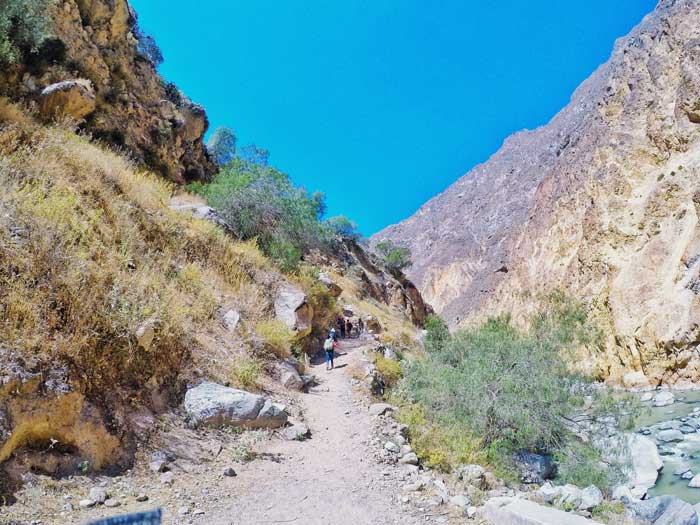
When we saw our accommodation from up and afar, my groupmates ran downhill without stopping, while I slowly made my way down with the help of my trusty companion – the life-saving, pressure-reliving trekking poles. Ever since I injured my knee while trekking Torres del Paine, I have been very cautious going downhill.
Sangalle was our village oasis for the night. A bright light-blue swimming pool surrounded by lush green trees and rustic adobe huts, it really seemed like an oasis. But it was getting cold and dark when we arrived in the evening, so we skipped the pool and went to the bar for happy hour instead.
Day 2 - 4:40 a.m.
We started off strong, racing against the sun rise, but the altitude soon took its toll on us. The non-stop uphill trail over rocks and stone steps was extremely steep, and the hundreds of trekkers looked like zombies in the dark. Instead of pushing forward, gravity resisted us. Every step felt like a torture.
Breakfast was only available at the village AFTER the climb. I ate a snicker bar before starting, and had another bar while I climbed. It wasn’t enough, I stopped multiple times for chocolates too.
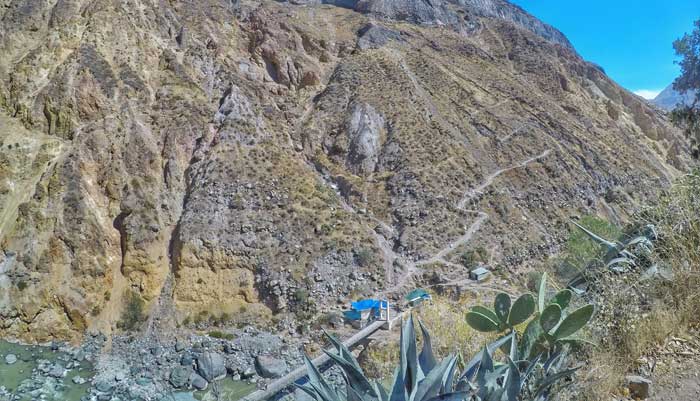
The sun slowly rose at 6, casting a faint orange glow on the green valley. Even in my exhausted state, I couldn’t help but feel rapturous at the beauty. I looked at the tiny houses on the opposite side of the canyon and couldn’t help but wonder: How do they do this every day?
My thighs started to cramp midway. I paused and stretched. Breathing was noticeably more difficult. I was acclimatised to the altitude after a month in Bolivia, but other trekkers weren’t as lucky. Some had headaches, others had nausea.
As I continued climbing what felt like a thousand brutal steps, I heard hooves clattering against the ground. Mules - carrying bags and riders who had given up - overtook me. They seemed like a tempting option at that time.
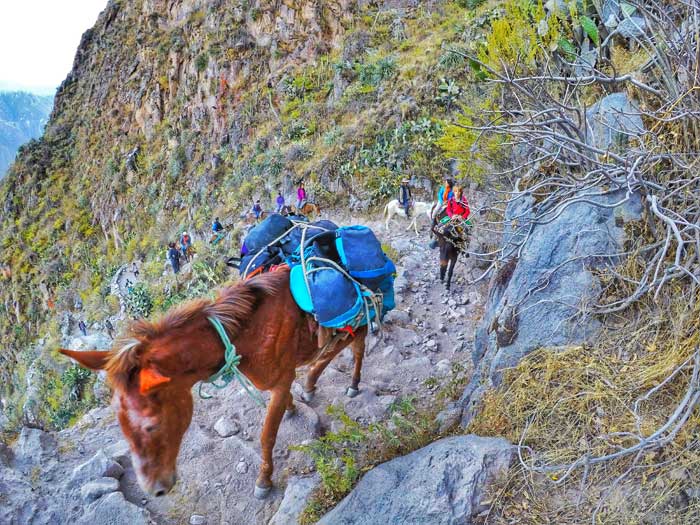
But no, keep fvcking going, I told myself.
At last, when I reached the precipice of the canyon, the sun had fully risen. The weather went from the dark cool night to the warm sunny morning, from wearing two layers of jackets to just a T-shirt.
Everyone at the top agreed that was a truly intense hike; 1100m in elevation change was enough legs’ day for me for the next year.
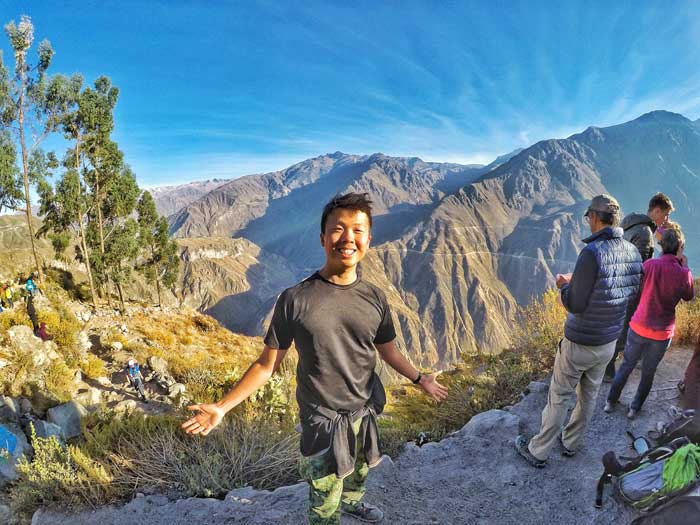
Breakfast was a 15min walk away at the town of Cabanaconde and by that time, my legs felt like jelly. The scrambled eggs at breakfast made everyone happy.
The tour bus brought us to Chivay, where we had a dip in the hot springs. The PEN $15 (USD $4.50) entrance fee wasn’t included in the price of the tour, and the water wasn’t hot at all. Still, it was a relaxing dip.
At Chivay, we had lunch at a restaurant. My group skipped the PEN $30 (USD $9) buffet lunch (with limited options) and ordered a-la-carte instead.
On the ride back to Arequipa, we stopped along the way for photos of the spectacular valleys, majestic volcanoes and furry llamas and alpacas.
This trip had me gain a newfound respect for advanced hikers, and an even deeper appreciation for the inhabitants of the unforgiving Andean mountain range. Like seriously, how did they do it back then?
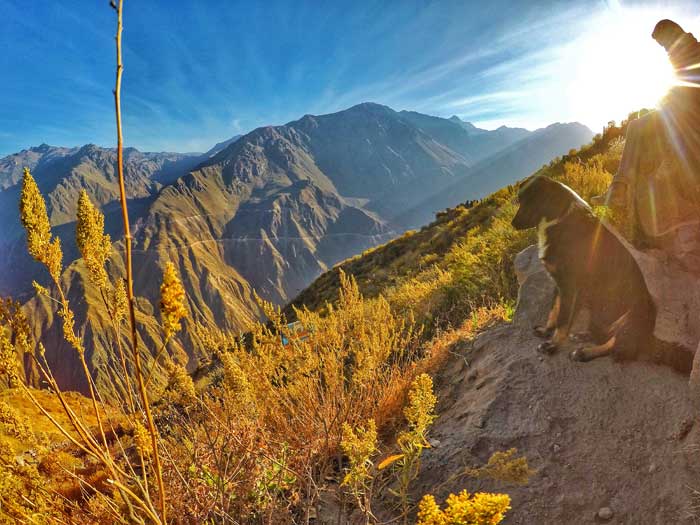
Hiking the Colca Canyon is great training for trekking Machu Picchu. The altitude reaches 4800m -way higher than Machu Picchu - and is perfect for learning how to deal with altitude sickness. I’m not sure about you, but I’d rather face the effects here than at one of the 7 Modern Wonders of the World.
Points to Take Note:
- The 3-days trek is touted as an easier trek, doing the same route but allowing more time. I felt that the only tough part is the final day ascent, and there is no break in-between. You pretty much do the whole ascent on the third day like in the 2-days trek, so if you’re considering it for an easier time, don’t.
- But if you do the 3-days trek, you get to enjoy the pool in the oasis, since you arrive there on the 2nd day afternoon.
- Bring an overnight backpack for clothes, toiletries, water and snacks but pack light!
- I paid PEN $120 for the 2-days trek, booked through my hostel.
- Agencies work together to fill their buses, so it doesn`t really matter who you book with.
- Entrance fee is PEN $70, buffet lunch is PEN $30, hot spring is PEN $15.
- You can rent swim wear and towel at the hot springs for ~PEN $5.
To DIY without a tour, take a bus from the bus terminal in Arequipa to Cabanaconde (6 hours). Calculate when you wanna start the trek (9am? Take the 3am bus). The popular villages for tour groups are San Juan and Sangalle. You can also choose to stay at Llahuar.
Truthfully, you don’t save much and it’s not worth the hassle, so I’d recommend taking a tour.
And now, it’s your turn.

